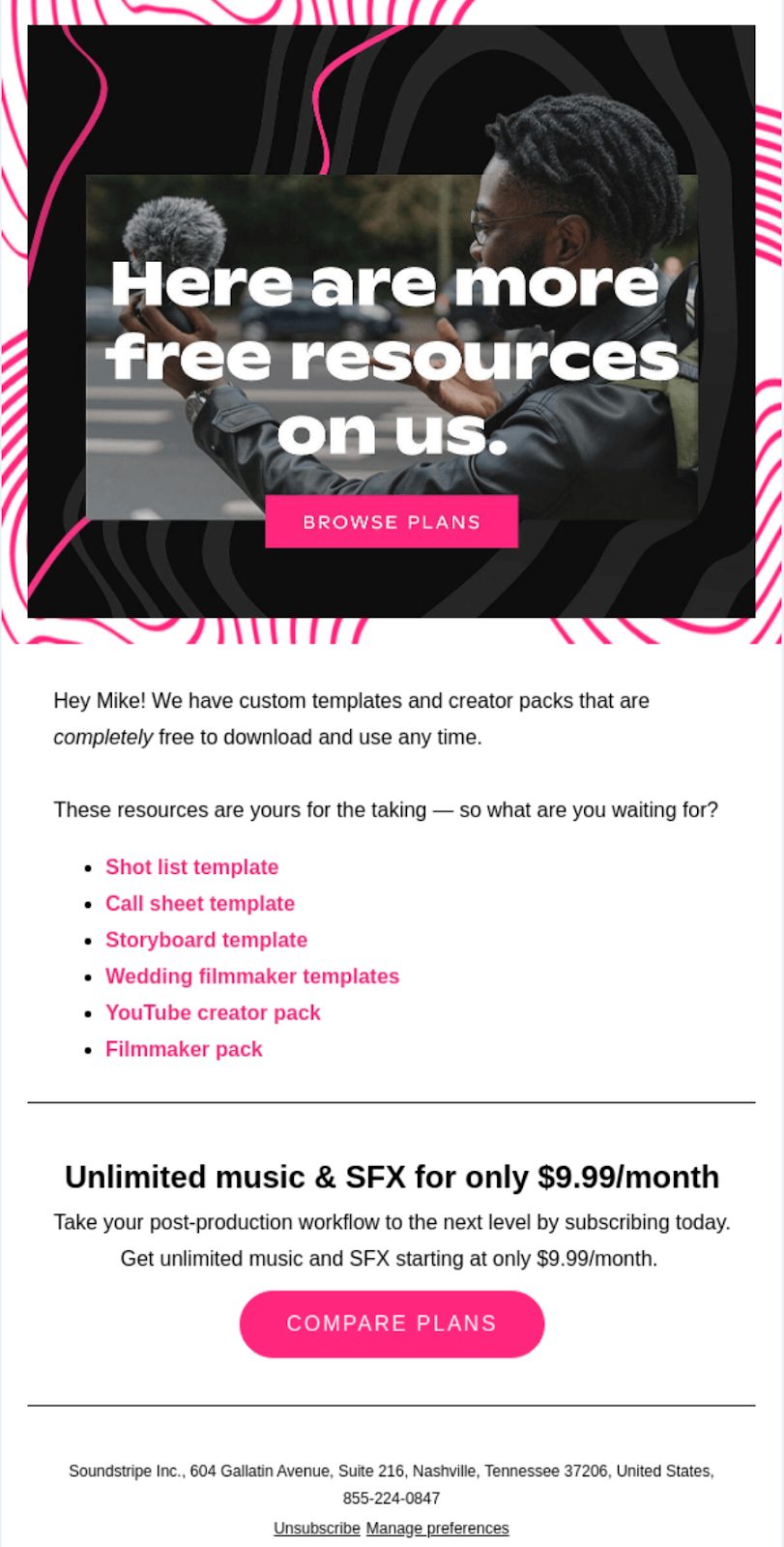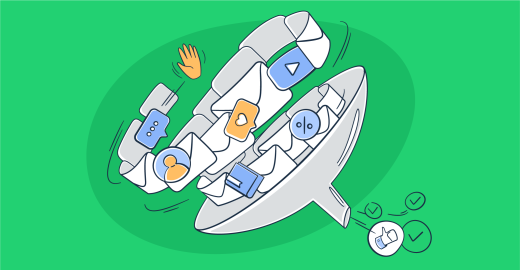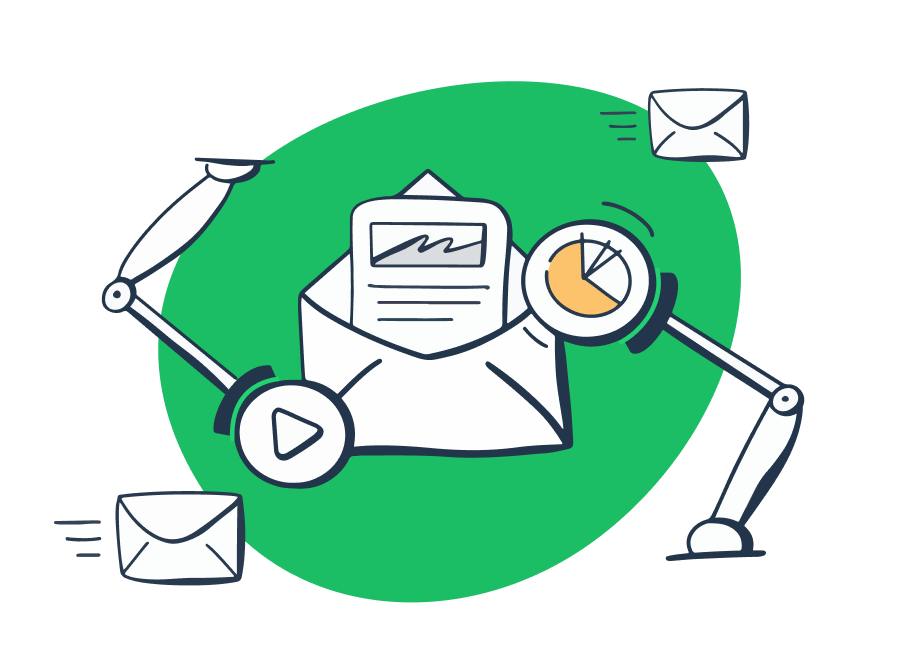With a projected ROI of $40, email marketing is hard to ignore.
However, it’s not only about creating compelling email content to get more bang for your buck; if you build up a killer email marketing funnel, you’ll get much more out of it.
In a perfect scenario, paying customers become the best brand advocates. Then, their love quickly turns into referrals, leading more people to jump on the bandwagon.
But note that creating a funnel that doesn’t leak leads is both an art and a science. So let’s see how to design a clever email sequence that puts a smile on everybody’s face. 😉
What is an email marketing funnel?
An email marketing funnel is a framework to strategically structure email campaigns to guide potential customers through each stage in the customer journey.

With a funnel in place, your brand reaps the following benefits:
- You get to nurture leads from the very beginning.
- Improved personalized marketing – increase trust and brand authority in the eyes of potential customers.
- With automation tools, it’s very easy to track vital metrics, then test and iterate until you find what best resonates with your audience.
- Increased ROI, assuming your emails keep the recipients in the funnel.
Here’s a breakdown of each stage with snappy explanations of how these relate to your audience.
Awareness stage
The goal is to make potential customers remember your brand and what you offer.
Know that the awareness stage is the first touchpoint with your brand – the first email the potential customers get. Therefore, in-your-face offers won’t work. Actually, you shouldn’t attempt to sell anything right away, even if you’re an eCommerce, or there’s a high chance your leads will drop off immediately.
However, grabbing their attention with a clever solution to your email subscribers’ problem is a must. And it’s best to do that using common digital marketing hooks such as newsletter offerings, infographics, checklists, PowerPoint templates, free webinars, etc.
Interest (or Engagement) stage
Once the recipients are aware of the brand, the next step is to pique their interest. You should make them hungry for more based on the potential customers’ needs, desires, and, you guessed it, pain points.
Educational content, such as blog posts, how-to guides, eBooks, tutorials, etc, is a great way to nurture potential customers’ interest. The goal is to establish authority, then continue offering quality content for strategic lead nurturing.
To stress, you still shouldn’t be selling anything, though there’s a bit of a caveat to that, which we cover in the examples section.
Consideration stage
The recipients are now in the middle of the funnel and things start to turn in your favor.
Lead nurturing emails in the Interest stage have done their job, and a potential customer is actively considering your product or service as a solution to their problem.
Sure, many marketers hear cha-ching at this stage but keep your sales impulses on a leash. Also, note that the new leads are likely to compare your solution to the competition. So, you need to find a clever way to offset that and nudge your leads to the next stage.
Emailing potential customers with case studies to highlight the product or service benefits typically helps. Product demos or other videos that showcase the benefits of your product also work. And, if you have the capacity to organize a free webinar for these leads, you might convert them pretty fast.
Conversion (or Purchase) stage
This is where potential customers become new customers!
Of course, there are marketing tools to woo your leads, remove shopping friction, and motivate them to hit the “Buy Now” button as soon as possible.
Sending out promos and special offers such as free trials, discounts, bulk offers, etc, is the way to go. But be careful with these series of emails, particularly the time-based offers designed to imbue a sense of urgency.
Why?
There are industries where the target audience might frown at such offers and may find them too pushy and marketish. A good example could be a B2B SaaS where migrations to new solutions don’t happen in a snap. The bottom line is that you need to test and tweak until you find the right approach.
Retention stage
Once a lead makes a purchase, it’s essential to focus on customer retention and keep them engaged. You need to tactfully continue the automated email campaign to build a pool of loyal customers. Moreover, you can use phone systems to further provide necessary support.
Yes, we’re stating the obvious, but let’s look at it from a different angle.
The retention stage isn’t only about making your customers come back for more. Sending relevant follow-up emails to existing customers can do wonders for your brand awareness and advocacy.
How?
Word-of-mouth can cause a ripple effect and bring in more qualified leads, driving down CAC (Customer Acquisition Cost). Of course, we’re assuming you’re offering highly valuable content.
Lastly, you should carefully weigh when and how to upsell or cross-sell the customers based on where they are on the buyer’s journey. To do this right, monitor how existing customers interact with the targeted content you provide.
Email marketing funnel examples
By now, it should be pretty clear what an email marketing funnel looks like and how to approach users in each stage. However, it pays to take a look at some real examples to gauge which type of email moves the dial.
In the example below, we can assume that a potential customer got interested in image editing and management software, landed at Adobe’s Lightroom, and might have even downloaded the free version.

This is a welcome email, typical for this stage of the funnel. But a few aspects make it a great awareness stage offering.
- The email has an optimal structure (the balance of graphics and messaging in the template).
- It offers useful links to instruct the users on how the product improves their creative flow, leading either to the Lightroom blog or their knowledge base. And it softly introduces the fact that Lightroom is a well-integrated, cross-platform, solution.
- There’s no proper, sales-oriented CTA but rather links to get the software on different devices.
- The email only has one topic and one goal – to welcome users to the community and make them an active part of the community. In this particular case, that’s the highest value for new subscribers/prospects.
Warming up the leads in the interest stage
Our friends at Calendly really nailed their interest stage email, so it pays to dissect each aspect.

The email starts with intriguing stats, but Calendly isn’t just throwing numbers. The average they’re discussing directly relates to the software and the vital pain points of the avatar – booking meetings and sales friction.
Next, the email follows with highly-valuable educational content. This time it’s a free guide, but an eBook or a free webinar would also work within the given niche.
Then, there are more high-quality resources, all under the “Hear from our experts” subheader. The goal is to build authority and rapport while offering something that’s really useful for the avatar.
Lastly, the email finishes off with a soft CTA (Call to Action) for a demo, suggesting one of the highest values is seamless collaboration. Now, one could argue that this should be placed in the conversion stage email. But we already mentioned that there’s a caveat for the interest stage emails, so let’s explain.
Calendly is a unicorn and one of the most popular scheduling software. With mature brands, it’s okay to leverage the existing stardust and gently lead users toward conversions at the top of the funnel.
Also, the CTA isn’t the same as you’d find in promotional emails or conversion emails. Instead, it’s more of an invitation to take communication to another level.
Landing sales in the conversion stage
Soundstripe has a well-thought-out funnel strategy and their conversion stage email attests to that.
At the bottom of the funnel, the music library continues with content marketing that helps their avatar speed up the video production process.
To be specific, by giving away miscellaneous templates, Soundstripe attempts to lend creators more time to be creative in choosing the music – all aimed at removing the shopping friction.
Speaking of shopping, it pays to analyze their CTA since it’s masterfully integrated. Here are the main takeaways:
- The copy leading to the CTA button features the offer and value proposition. Both are transparent and flow seamlessly with the rest of the email. There’s no “buy one, get one for free” lingo that might deflect the recipients.
- The CTA button copy says: “Compare Prices”, it’s not “Get Now”, “Buy Now”, or “Upgrade your plan”. The reasoning behind the approach is that Soundstripe wants users to make their own choice, rather than being told what to buy. Honestly, it’s a clever trick to make users feel more confident about their choice and your brand in general. Plus, it plays upon the fact that users typically do a lot of comparisons in this and earlier stages.

How to create an email marketing funnel?
It’s not rocket science…
But, there’s a bit of work to do if you’re to apply a proper email marketing funnel strategy. Generally, that means you’ll have to develop email flows to move leads from one stage to the next seamlessly.
Anyway, here’s the framework to help you do that:
Step 1: Identify your target audience
Knowing the audience’s pain points, desires, and expectations informs the messaging that’s likely to keep the prospects in the funnel. Though, this bears the question – how do you know what they want?
Out of all the marketing tips you might find, the good old manual market research is usually the most helpful. Go to social media, Twitter in particular, check niche forums, software catalogs, or product comparison websites, and pay close attention to your customer reviews (if any).
But don’t just gather info; categorize it in a meaningful way so that your marketing team can convert the user-generated comments and concerns into a buyer persona, then into direct messaging. The categories may include the following:
- Who’s your avatar (specific info about the qualified prospect – the buyer persona).
- Target avatar’s pain points.
- Faults of your competitors (what users don’t like and what might annoy them).
- What the target avatar likes about your competitors.
- Feature and/or performance expectations.
- What users want to achieve with the product or service.
- Etc.
Step 2: Map out your customer journey
A map of the customer journey is an invaluable visual resource that shows all the touchpoints with your brand from the moment potential prospects get into the sales pipeline CRM.

Also, mapping out the customer journey allows you to answer four critical questions in marketing – Who, When, Where, and How. In other words, you’ll understand the preferred user flow when it comes to interactions with your brand. And that helps customize the content to potential customers’ behavior and desires.
For instance, you may realize that prospects like demos (see the Calendly example covered earlier) and video content early in the funnel. Or that you need to share case studies and user stories in the awareness stage emails. Whatever it is, make sure that you follow suit and offer users what the data suggests they like.
As for the data sources, you can’t go wrong with Google Analytics, Looker Studio, Salesforce, etc.
Step 3: Create awareness
A good way to generate awareness is to create and/or promote informative and educational content, such as blog posts, social media posts, opt-in forms, or videos that showcase your products or services.
You can do it organically (SEO usually) or via paid campaigns. On top of that, some companies are now utilizing AI for SEO. As always, it’s important to test and see which approach works best for your brand.
Tip: Use attention-grabbing headlines and visuals to make your content stand out.
Step 3: Capture leads
Once you’ve created awareness, the next step is to capture leads. It’s best to offer something of value in exchange for the reader’s contact information. Freebies such as e-books, webinars, or even consultations do the trick.
Tips:
- Your lead magnet must align with your target audience’s interests and provide real value.
- Be careful with pop-ups and opt-in forms, some people find them annoying.
Step 4: Nurture leads
Once you’ve captured leads, it’s important to nurture them by providing engaging content that moves them further down the funnel. This can be achieved through email marketing, but also social media, or retargeting ads.
Tip: Segment your email list based on their interests and behaviors to provide personalized content. More on that in one of the sections below.
Step 5: Convert leads into customers
After nurturing, the next is the “money” stage. You can achieve it through email marketing campaigns or landing pages that highlight your products or services and provide a clear CTA.
Tips:
- Use social proof, such as customer testimonials, to build trust and encourage conversions.
- Analyze where the conversions typically occur – landing pages, blog posts, or maybe your leads go directly to the pricing page. This will inform your sales pitch and the content you offer within the emails.
Step 6: Retain customers
Once you’ve converted leads into customers, it’s vital to keep them by providing excellent customer service, personalized content, and exclusive offers.
Tips:
- Leverage email automation and customer behavior to keep providing relevant content and offers.
- If you’re an eCommerce, reduce cart abandonment by A/B testing a few “abandoned cart” emails.
What’s next?
The next thing is putting everything to good use. So, the following sections will tell you how to do email marketing to create an awesome conversion funnel. We cover lead generation, segmentation, and key metrics.
Of course, you also need a strategy to give your efforts a meaningful framework. If you want to dive into details, check our blog post on how to create an email marketing strategy.
And now, let’s start with lead generation.
Generate qualified leads
Lead generation is the ‘art’ part of creating an email marketing funnel. And it all starts with creating and testing your lead magnet. But we should first define the qualified leads.
Simply, qualified leads are the people interested in the service or product you’re offering, and they’re ready to learn more. These qualified leads can be attracted via either inbound or outbound lead generation strategies.
From a more technical perspective, a qualified lead is someone who’s already in the awareness stage. That is – the person expressed interest (got hooked by your lead magnet) and willingly provided information (email address) to enter your funnel.
It’s vital to stress that the person willingly entered your funnel. Otherwise, they won’t go past the awareness stage emails, and that will reflect on your deliverability stats – Unsubscribes, Spam complaints, and Click-through rates, in particular.
The bottom line is that you should never attempt to create a funnel with a purchased email list. Instead, focus your efforts on designing an alluring lead magnet.
What’s a lead magnet?
A lead magnet represents the valuable resource you offer to the target audience in exchange for their contact information. The type of resource you offer depends on your audience and their preferences.
For example, if you sell software that helps people manage their finances, you could create a lead magnet in the form of a free budgeting spreadsheet or a guide to saving money.
Lastly, you should offer the lead magnet organically (your website, blog posts, etc.), but also expand your reach through paid campaigns on social media or wherever your leads might be.
Segmenting leads
Segmentation means grouping leads based on shared characteristics, interests, or behaviors. This kind of grouping, based on predetermined criteria, empowers you to create personalized, targeted email campaigns that are more likely to convert.
Here are the “Hows”:
- Determine segmentation criteria
Before you start categorizing potential customers, decide on the criteria to use. These may include demographics, interests, behaviors, or where the lead is in the sales funnel. Make sure your criteria are relevant and useful for your overall marketing efforts.
- Monitor engagement
Pay attention to how your leads engage with emails. You might notice that some are more likely to open your emails, while others click on links or make purchases right away. Use this information to segment the leads and create more drip campaigns.
- Automate your process
As indicated earlier, marketing automation platforms can help expedite lead segmentation based on specific criteria, such as behavior on your website or engagement with emails.
- Rinse and repeat
Continuously refine and test the segmentation strategy using A/B testing. This will help you improve your email marketing results in the long run.
Measuring results
Measuring the success of your emails is essential to optimize campaigns for better performance. To achieve this, you need to use tools such as Mailtrap and keep track of various metrics that provide valuable insights into your campaigns’ effectiveness.
Here are the percentages you need to hawk over:
- Open rate
This is the percentage of recipients who opened your email. A low open rate could indicate that your subject line requires improvement or that your emails are landing in spam folders.
- Click-through rate
It’s the percentage of recipients who clicked on a link in your email. This metric helps measure how engaging your content is. If the rate is low, then your content or offering is missing the mark.
- Conversion rate
The percentage of recipients who completed a desired action, such as making a purchase or filling out a form, is called the conversion rate. This is the most significant metric to measure, as it directly impacts your business goals.
- Bounce rate
The bounce rate is the percentage of emails that failed to reach their destination. A high bounce rate may signal that your email list needs cleaning or that your emails are getting flagged as spam. Also, your email infrastructure may possibly require a technical inspection.
- Unsubscribe rate
This is the percentage of recipients who opted out of receiving your emails. A high unsubscribe rate could indicate that your content is irrelevant or that you are emailing too frequently.
- ROI
The return on investment (ROI) is the revenue generated by your email campaigns compared to the costs incurred. This metric is crucial to track as it ensures that your campaigns are delivering a positive return.
3 tips for a better email marketing funnel
- Troubleshoot
If you’re not seeing the desired results from the funnel, it’s critical to identify the root causes right away. Or, your marketing efforts might go to waste.
As hinted, look at your open rates, click-through rates, and conversion rates to pinpoint where your funnel might be falling short. Then, try A/B testing different elements, such as subject lines, copy, or CTAs, to see what works best.
Make sure that the technical aspect of your email infrastructure is good. For example, if you’re getting a lot of bounces, and spam complaints or your open and conversion rates suddenly drop, you should check if the backend of your email campaigns is working correctly.
- Maintain your email list
Clean up your email list regularly by removing inactive subscribers or those who haven’t engaged with your content in a while. To do this, you can use software like Mailtrap, which allows for the automatic suppression of all hard bounces, unsubscribes, and spam complaints.
This will help ensure your email metrics remain strong and that you’re not wasting resources on subscribers who are no longer interested.
- Experiment with email frequency and timing
Finding the right frequency and timing for your emails can have a significant impact on engagement and conversion rates. Experiment with different schedules and analyze the results to determine what works best for your audience.
Remember, the key to maintaining a successful email marketing funnel is to regularly analyze and optimize your strategies based on data and feedback from your audience.
The funnel we trust
From the first time someone interacts with your brand, to onboarding and retaining existing customers, all your marketing efforts should be focused on testing and optimization.
This article gave you the blueprint for an email marketing funnel, but it’s not a set-and-forget thing. You need to keep going back to the funnel, determine how your leads behave, and adapt to that in order to keep optimizing it for maximum effectiveness.





